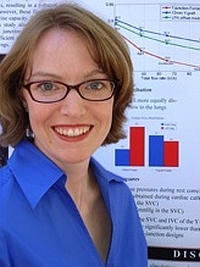Engineers at University of California in San Diego are devising computer simulations of a widely used pediatric heart pump to reduce the risk of blood clots to patients using the device. Mechanical/aerospace engineer Alison Marsden (pictured left) and structural engineer Yuri Bazilevs are leading teams of colleagues from their respective disciplines to better understand a cardiac pump for young children who cannot yet wear an adult-sized pump.
Marsden, Bazilevs, and colleagues are are studying the Excor pediatric ventricular assist device made by Berlin Heart, a medical device company in Germany. The Excor pediatric system is designed to support pediatric patients of all age groups suffering from heart failure to provide a bridge for patients awaiting heart transplants for up to several months, until a donor heart becomes available. The device has been approved in Europe and Canada, and in December 2011, was approved by the Food and Drug Administration for use in the U.S..
The Excor pediatric hear pump, however, is associated with a 40 percent risk of developing blood clots, which can lead to strokes or embolisms. The pump has two chambers: one for blood, another for air, separated by a flexible membrane. The air chamber is pressurized, which drives the membrane to pump the blood. Because of the complex interaction of blood, membrane and air, blood flow created by the Excor device is difficult to simulate.
The San Diego researchers are combining their expertise to develop sophisticated mathematical tools to model the flow of blood through the device. Marsden’s current work involves the development of blood flow simulation algorithms to test and optimize heart surgery designs on computer before trying them on patients. Bazilevs focuses on computational science and engineering for complex, high-performance computing applications, including simulations of airflow for wind turbine blades to air flow and water interacting with the hulls of high-speed ships.
“Yuri [Bazilevs] has been essential in training my team in complex mathematical methods,” says Marsden, “such as finite element methods, and providing expertise in the development of cutting-edge computational methods.” Bazilevs adds that “Current commercially available codes are not capable of handling such problems, which necessitate the development and implementation of advanced procedures for the interaction of fluid and structure for this class of applications.”
As a result, the research team has successfully simulated blood flow inside the pump. Their current studies are trying to better understand how blood clots form inside the pump. The next stage will use simulations to identify design changes needed in the Excor device to reduce the risk of clots.
Read more:
- Feasibility Demonstrated of Tiny Wireless Cardiac Implants
- Companies, University Team-Up on Drug Side Effects Model
- Math Model Helps Predict Future Medical Problems
- Injectable Gel Material Devised to Treat Heart Tissue Damage
- Math Model Helps Predict Unknown Drug Side Effects
* * *


 RSS - Posts
RSS - Posts
[…] Simulations Helping Design Cardiac Pump Improvements […]
[…] Simulations Helping Design Cardiac Pump Improvements […]